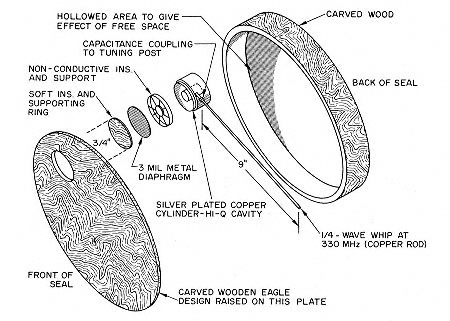Seal Lyin’
For a brief moment in history — that is, during part of World War II — the Soviet Union and United States were allies. While history reflects upon that alliance as one of convenience, with the two nations bound by a common enemy, there’s some evidence that the two were, in the least, friendly at times during the War. One such example: On August 5, 1945, the day before the United States dropped the first of two atomic bombs on Japan, the Soviets presented the Americans with a gift — the Great Seal of the United States (seen here) carved out of wood.
Such a gift was welcomed and displayed with affection by the U.S. Ambassador to the Soviet Union in his study. And it remained there until 1952, when a British radio operator accidentally noticed that he could hear what those in the study were discussing. The study was bugged, and the Great Seal was the culprit.

The seal contained a bug no larger than a quarter. And the bug, as depicted in the schematic above, was ingenious. It lacked something most devices are assumed to contain — a power source. As Wikipedia notes, the listening device had no electronic parts whatsoever. The bug, about the size of a quarter, was a small diaphragm placed over a metal cavity, which in turn was connected to an antenna. The diaphragm would vibrate in reaction to sound in the room; these vibrations could be detected by the antenna. In and of itself, though, that would do nothing whatsoever.
However, if the Soviets beamed radio waves at the Seal — which they could do from a sizeable distance, say, parked outside in a van (and that’s exactly where they were) — that would all change. The antenna would reflect the radio waves back to the van, but the reflected waves would be changed by the diaphragm and, by extension, carrying a “picture” of the sounds in room with them. (This is called “modulation.”) A radio receiver on the proper frequency could translate those modified waves back into the sounds the bug originally captured. (This is similar to how RFID chips — the tap-to-buy chips in your credit cards — work.)
Because of this feature, the bug was not only difficult to detect — traditional tools for finding electronic devices won’t turn up something which is not, in fact, electronic — but it was also, potentially, timeless. As it did not have a battery, there was no risk of that core component going dead, rendering the entire device obsolete. Had it not been discovered — and by accident, at that! — the Great Seal Bug may have outlasted the Cold War.
Bonus fact: Not all intelligence endeavors were so high tech. In World War II, the U.S. War Department issued a comic/guide to soldiers stationed in China titled “How to Spot a Jap.” The guide, using terms offensive to modern readers, came up with a number of ways to tell if the person you were with was, in fact, a Japanese spy. One part (available here) tells soldiers were advised to get the people in question to say the word “lollapalooza” because, per the stereotype, Japanese natives could not say the “L” sound properly, and would instead replace it with an “R” sound, thus outing themselves as the enemy.
From the Archives: Acoustic Kitty: Spy cats… gone wrong. Horribly, horribly wrong.
Related: The Eviltron. Much like the listening device in the Great Seal, the Eviltron is only about the size of a quarter. Unlike the Great Seal Bug, the Eviltron contains batteries, and is by no means silent. Rather, it is anything but. At random intervals, it creates one of five creepy sounds. Buy a few, stick them around the office, and cackle in the plight of your co-workers.

Leave a comment